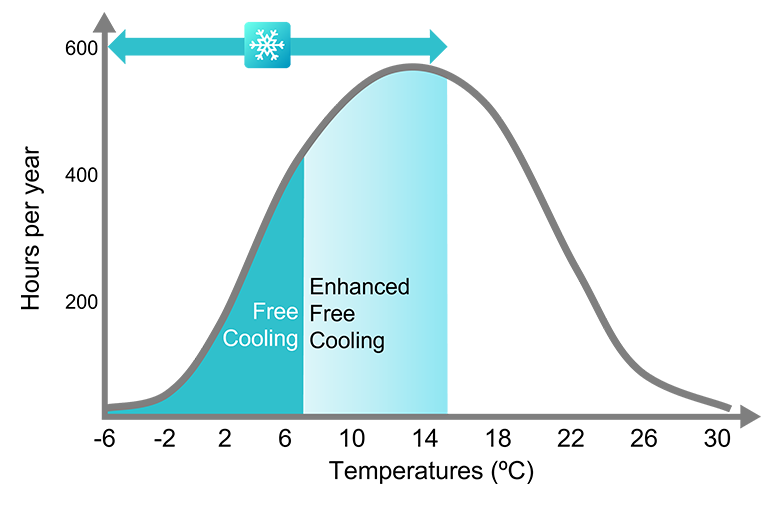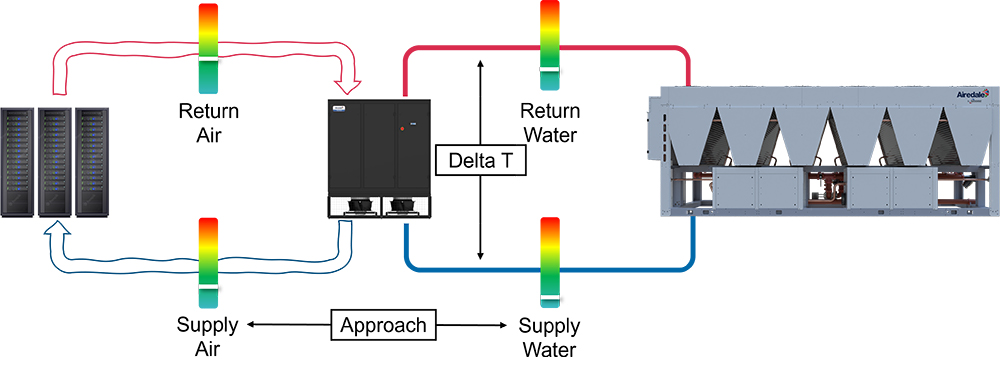12 October 2023
|
Airedale recently released a white paper claiming that up to 44% energy savings can be achieved by applying advanced technology to “traditional” air-based cooling systems in modern data centre designs. We had the opportunity to chat with Patrick Cotton, Product Manager for Chillers and author of the white paper, to explore the topic further.

Patrick, data centres are nothing new but the sustainability talk around them is definitely ramping up. What’s your take on why that is?
It comes down to scale. In 2023 there are approximately 5.19 billion people online. These people are all sending and receiving data from over 15 billion devices worldwide that are connected to the internet. All this is creating avalanches of data that needs to be stored. On top of this, we all know that AI is just around the corner. In order to automate our world and for machines to start thinking for us, data is going to have to be created, communicated and analysed in quantities that are mind-blowing. It will dwarf what has gone before it.
The data centre industry is already in the middle of a big growth cycle. We’re trying to do things bigger and faster. But we also know that all this power comes with great responsibility. As we take a larger share of Earth’s natural resources, like electricity and water, this growth HAS to be sustainable. We can’t just use even more electricity to power AI. We need to figure out how we serve the planet without harming it.
This is why hyperscalers, colocation providers and key supply chain players like Airedale are working together with a laser focus on energy efficiency. These industries need our help to engineer the cooling solutions that will help them run net zero data centres. That has to be the ultimate goal, to not take more than we put in. It’s a massive challenge and it will be solved by engineering innovations.
There is a lot of talk in the data centre industry about liquid cooling but this white paper focuses on more traditional, mature technology like chillers. How has Airedale pushed the technology forward to offer something different?
It’s true…chillers have been around since the 1920s and we’re still using them today to cool data centres. And the core technology; compression and evaporation of refrigerant, heat exchange between refrigerant, water and air, hasn’t changed.
But look at the internal combustion engine. If you put a Ford Model T next to a Toyota Prius today you’d think they were completely different things. The internal combustion engine principles remain the same but the technology has improved to move the motor vehicle far beyond the original concept. The same has happened with chillers and the other cooling technology we use to keep data centres cool.
We have used a blend of mechanical upgrades, software enhancements and optimising the cooling system as a whole to really stand at the front of the field when it comes to data centre energy and water efficiency. We have been making chillers since 1984 and every year our R&D teams go into the labs and challenge each other to push the envelope that little bit further. How can we make this more efficient? How can we make it more resilient? How can we make it more intelligent? How do we make it work with new refrigerants that are better for the environment?

The white paper talks a lot about free cooling. Why is this so important?
One of the things Airedale does, we would argue better than anyone else, is free cooling. Free cooling is pretty self-explanatory as a concept…it is about using the outside, or ambient, temperature, to keep the data centre cool. Cooling for free. Or cooling that uses vastly less energy than standard mechanical cooling at least. The technology needed to do this, and do it well, is complex. You can’t just dump the outside air inside the data centre. The computer room air handlers inside the data centre, the chillers, the software that manages it all, have to be fine-tuned and set up to deliver the maximum amount of free cooling possible. We have pioneered free cooling technologies and techniques that allow operators to operate in free cooling mode for up to 98% of the year, depending on climate.
Driving free cooling performance improvements relies heavily on heat exchange performance. You can tweak parameters like depth of condenser coil, coil fin pitch and the pressure drop on air and water side. The key is finding the perfect balance between heat exchange, pressure drop and material costs. The white paper talks about a technique we have developed called Enhanced Free Cooling™. We feel we have found that perfect balance by adding additional rows in free cooling coil, accommodated by adjusting the pitch of the coil within v-block condenser. Increasing the diameter of the EC fans then delivers more air across the heat exchangers and pushes free cooling capabilities higher. However, the fan power input must be balanced to ensure an energy performance benefit is realised.
Design ambient is another key factor influencing fan power, so in DX mode our patented, optimised head pressure control feature manages fan speed to ensure fan and compressor power are balanced.
On top of increasing the number of hours per year the chiller spends in free cooling mode, Enhanced Free Cooling delivers secondary benefits such as lower pump speeds and pipework savings as a result of lower flow rates.

Where does air-based cooling go from here? Will it eventually be replaced?
The chiller is for sure a mature technology, the improvements from here are going to be an evolution rather than revolution. But in an always on industry like data centres, incremental efficiency improvements extrapolated over hours, days, weeks, years of use…can mean massive savings in carbon footprint. The white paper shows that using Airedale enhanced cooling technologies, can provide energy savings of 44% vs. standard practises. We’re talking savings of 787 tons of CO2 for a 10MW site over the course of a year. Given sites are growing to over 100MW and more these days and operating for 20 years or more, you can see why we’re excited about what we’re able to offer our clients as they push towards more sustainable facilities.
As IT workloads evolve, the heat dissipated by servers will in some cases be too much for air-based cooling systems to manage on their own, so for sure there will be an evolution and a need for alternative cooling systems, like direct to chip and immersion. However, while exciting applications like AI and cryptocurrency will see server densities rise, the vast majority of applications will remain in the comfort zone of chilled water cooling systems with chillers and CRAHs. These systems are proven in data centres, which goes a long way. As long as we can demonstrate energy efficiencies and keep striving for those incremental gains, we are confident that this technology isn’t going anywhere.
To request a copy of the Airedale white paper, click here.








